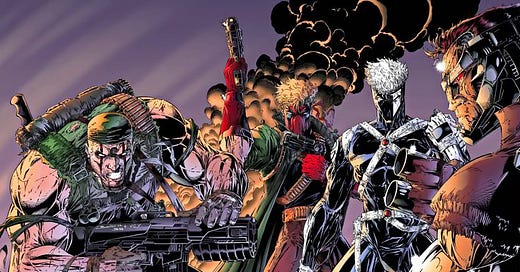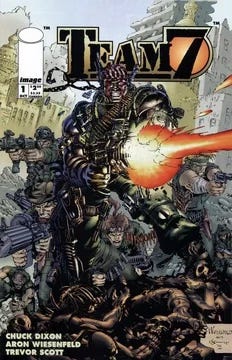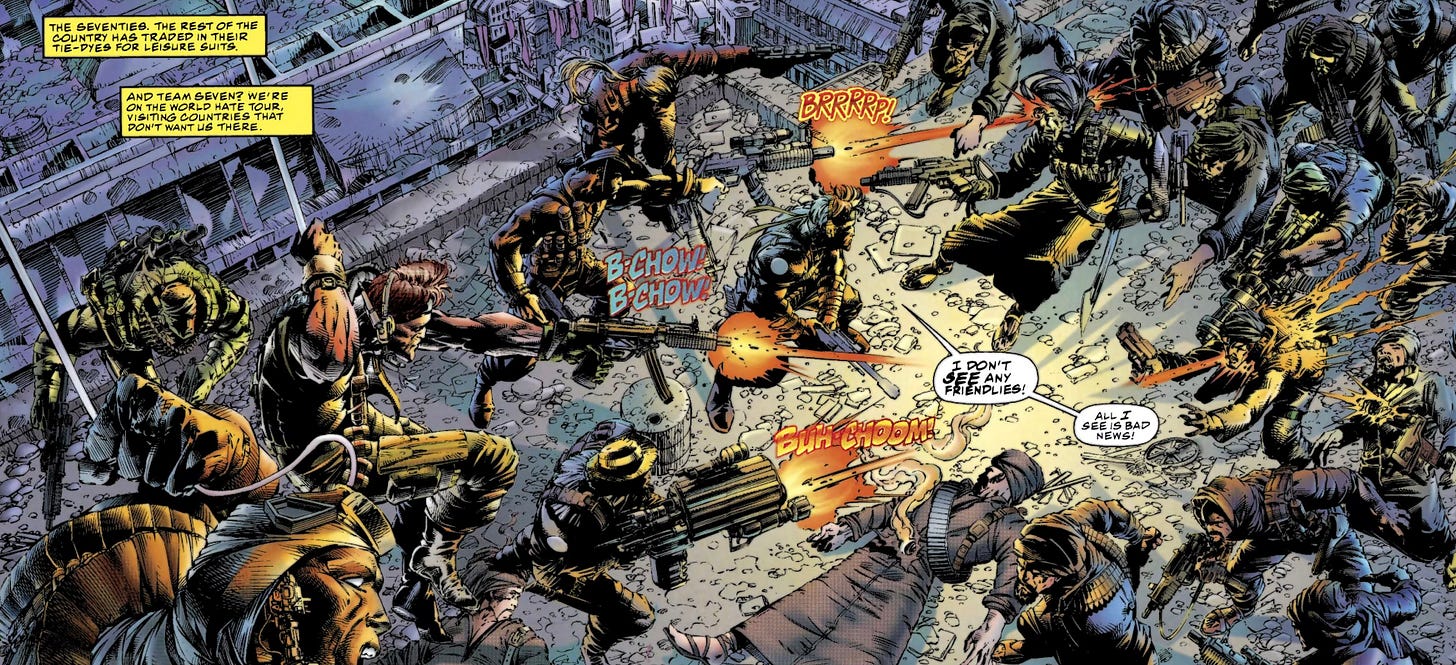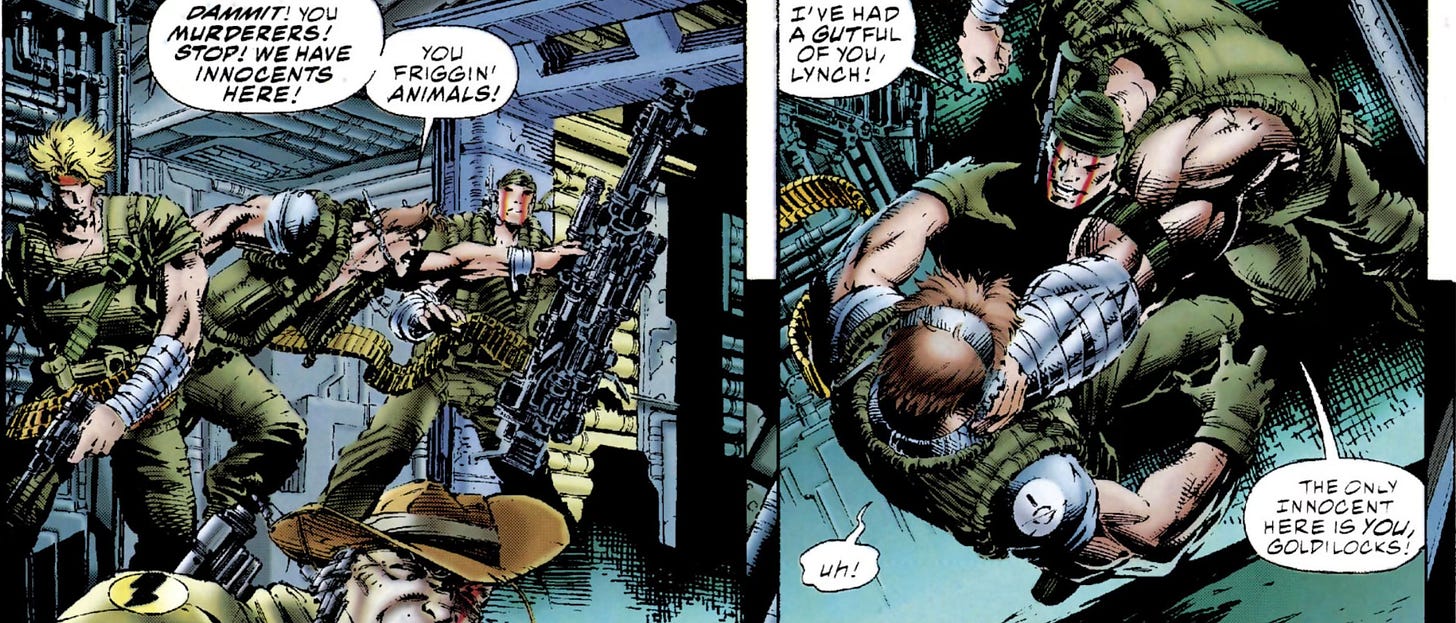Team 7 by Chuck Dixon
This is the start of a new series of articles on Generation X superhero teams.
Those of you who know anything at all about The Seven are a little curious as to, why did I start this series on Generation X superheroes with a team of Boomers?
Fair question. There are several reasons for it. First and foremost, one of the foundational truths of Generation X is that, while we’ve never liked it, we’ve had to live our entire lives in the shadow of the Baby Boomers. Any Generation X superhero team was going to have the same problem. They were undoubtedly being told how they sucked because they didn’t believe in communism but did believe in America.
While I could have done an article on Gen 13 without looking at their fathers in Team 7, it would save me a lot of time going over Gen 12’s background story and truthfully, Team 7 proved to be very important in forming the backbone the Wild Storm universe. It added a deeper background to a story that was just taking shape.
Besides Chuck Dixon wrote it and that’s as good an excuse as any to read something by The Legend.
Team 7 was published as a four-issue mini-series in 1994. Gen 13 had already been in print for a couple of years. And there was considerable reader interest in the parents of Caitlin Fairchild’s team as they kept making cameos and hinting at their dark backgrounds.
Team Seven takes place in the 70s and it has a lot of the tropes of that period. The team of top chair shooters who are betrayed by the men who sent them into harm’s way, like The Wild Geese, Rambo 2, or Predator. There are a bunch of others you probably thought of just now. Mention your favorite in the comments. It was a well-worn trope by the 1990s, although, having the team gain superpowers as a result of the betrayal was a kind of a new twist.
Team 7 is the 7th (actually 8th) incarnation of I/O’s special actions unit. It starts off as a tough-as-nails, gritty, and grim-dark military action saga.
When Chuck Dixon got this assignment he was somewhat constricted by the fact that the basic plot was already known because of Gen 13. This is honestly a very tough challenge for any writer. The fundamental problem with a prequel is this, the audience only thinks they want to know the story. For all the complaints about the Star Wars prequel trilogy, the real issue was simply that everyone knew what the story was going to be, years before they saw it. There were no surprises at all. Anakin turned to the Darkside because he had to. Luke and Leia’s mother had to die tragically because she was already dead by a New Hope. Obi-Wan and Yoda had to be where the audience first found them. No. Surprises. At. All.
Which is why prequels are fundamentally flawed.
Darklings: Aren’t you the one is who is ALWAYS saying…
Dark Herald: “A story succeeds or fails in the style of its telling.” Yes. That is very true and even knowing how a story ends has never stopped me from re-reading a favorite book or re-watching a favorite movie.
Regardless, it’s still a challenge to get right when the story can’t develop organically, you are stuck delivering certain fixed events and you have to deliver on making them interesting even though they won’t be a surprise.
The Legend absolutely nailed this one. The reception for this series was exceptionally positive and for good reason. Chuck Dixon delivered a high-impact story of a band of brothers who keep getting sent into the worst missions possible because they are the best. But after they are exposed to the Gen Factor and start gaining unearthly abilities they start turning on each other.
This was a very clever take. In any really strong relationship, there is a strong tendency for a self-reinforcing homeostasis. This is often a good thing if one person in that relationship has started to go downhill. “Honey, this has gone on long enough. It’s either me or the booze. And it’s going to be me!” Homeostasis, as I said.
However, the relationship will also be destabilized if one member starts to do exceptionally well. Take the budding romance author married to a blue-collar Joe who works at the cement plant. Once a month they have a big night on the town and go to Applebee’s. But then she has a monster hit and leads the NY Times best-seller list for a month. She is flown to New York to be interviewed, and her publisher dines her at Thomas Keller’s Per Se, and then she flies out to Hollywood because Margot Robbie wants to option her book. Then she gets home and her husband’s idea of a big night on the town to celebrate is… Applebee’s. She files for divorce by the end of the year.
Success will destabilize a relationship even more than failure. Team 7 are becoming different men and are being driven apart. That’s even without various members starting to have psychotic breaks. The team and their families are fractured.
The characters were what sold this story. Particularly Cash, who is trying to hold his band of brothers together and eventually has to put one of them down. Chuck Dixon once again displayed his genius for taking well-worn worn cliched stereotypes and then turning them into people you care about.
It examined the human cost of becoming superhuman, something humans were never designed to be.
Let’s not forget the artist. Team Seven is argued by many to have had the best artwork of the early 1990s It took Aron Wiesenfeld about a year to draw issue #1 of Team Seven. The art design is intensely detailed and intricate. It was incredibly dynamic, he took Neil Adams’s high-octane, hyper-speed stylistics and wedded them to Frank Miller’s minutiae. Printing technology had been evolving in the 1990s thanks to computers and it was allowing for drastically more vibrant visuals. Team 7 became known for its cinematic viewpoint, I remember thinking at the time that this was what the 1980s Swartzenegger blast-flick needed to evolve into.
The series helped establish Wild Storm’s reputation for darker themes while playing to the 1990s love of conspiracy stories like the X-Files.
I started this article just as a background piece and because I love Dixon’s writing, but now I am looking at Team 7 as an epically underappreciated piece of foundational comic book history. Wild Storm wouldn’t have been Wild Storm without the depth of story that Team 7 provided. I doubt if DC would have bothered to buy it up if it hadn’t been for Cash and his bros. And while DC didn’t do great things with it, I’m positive that Todd McFarlane would have done something much worse.
The original four issues are available on what’s left of ComiXology, it is definitely worth a look.
Discuss in the comments below








